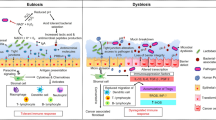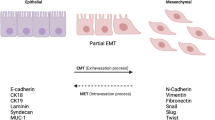Abstract
Deregulation of developmental signaling pathways such as Wnt/b-catenin and NOTCH are commonly observed in different cancers. A normal wnt pathway is essential for development and tissue homeostasis to preserve a normal balance between the differentiation and proliferation. PYGO2 is the main transcription factor of wnt pathway, while Msi1 is one of the wnt inhibitors. In this study we assessed the correlation between Msi1 and PYGO2 mRNA expression using Real time polymerase chain reaction in 48 esophageal squamous cell carcinoma (ESCC) patients. Although, there was not any significant correlation between the levels of Msi1 and PYGO2 mRNA expression, we observed a significant correlation between the Msi1 and PYGO2 overexpressed cases and depth of tumor invasion (p = 0.05). In conclusion, despite the role of these markers in tumor depth of invasion there is not any feedback between Msi1 and PYGO2 gene expression in ESCC.

Similar content being viewed by others
References
Andrews PG, Lake BB, Popadiuk C, Kao KR (2007) Requirement of pygopus 2 in breast cancer. Int J Oncol 30:357–363
Battelli C, Nikopoulos GN, Mitchell JG, Verdi JM (2006) The RNA-binding protein musashi-1 regulates neural development through the translational repression of p21WAF-1. Mol Cell Neurosci 31:85–96
Ben-Porath I, Thomson MW, Carey VJ, Ge R, Bell GW, Regev A, Weinberg RA (2008) An embryonic stem cell-like gene expression signature in poorly differentiated aggressive human tumors. Nat Genet 40:499–507
Ferlay J, Shin HR, Bray F, Forman D, Mathers C, Parkin DM (2010) Estimates of worldwide burden of cancer in 2008: GLOBOCAN 2008. Int J Cancer 127:2893–2917
Gholamin M, Moaven O, Memar B, Farshchian M, Naseh H, Malekzadeh R, Sotoudeh M, Rajabi-Mashhadi MT, Forghani MN, Farrokhi F, Abbaszadegan MR (2009) Overexpression and interactions of interleukin-10, transforming growth factor beta, and vascular endothelial growth factor in esophageal squamous cell carcinoma. World J Surg 33:1439–1445
Glazer RI, Wang XY, Yuan H, Yin Y (2008) Musashi1: a stem cell marker no longer in search of a function. Cell Cycle 7:2635–2639
Gotte M, Wolf M, Staebler A, Buchweitz O, Kelsch R, Schuring AN, Kiesel L (2008) Increased expression of the adult stem cell marker musashi-1 in endometriosis and endometrial carcinoma. J Pathol 215:317–329
Guo M, Jan LY, Jan YN (1996) Control of daughter cell fates during asymmetric division: interaction of numb and notch. Neuron 17:27–41
Headrick JR, Nichols 3rd FC, Miller DL, Allen MS, Trastek VF, Deschamps C, Schleck CD, Thompson AM, Pairolero PC (2002) High-grade esophageal dysplasia: long-term survival and quality of life after esophagectomy. Ann Thorac Surg 73:1697–1702 discussion 1702-1693
Imai T, Tokunaga A, Yoshida T, Hashimoto M, Mikoshiba K, Weinmaster G, Nakafuku M, Okano H (2001) The neural RNA-binding protein Musashi1 translationally regulates mammalian numb gene expression by interacting with its mRNA. Mol Cell Biol 21:3888–3900
Kawahara H, Imai T, Imataka H, Tsujimoto M, Matsumoto K, Okano H (2008) Neural RNA-binding protein Musashi1 inhibits translation initiation by competing with eIF4G for PABP. J Cell Biol 181:639–653
Moghbeli M, Abbaszadegan MR, Farshchian M, Montazer M, Raeisossadati R, Abdollahi A, Forghanifard MM (2013a) Association of PYGO2 and EGFR in esophageal squamous cell carcinoma. Med Oncol 30:516
Moghbeli M, Moghbeli F, Forghanifard MM, Garayali A, Abbaszadegan MR (2013b) Cancer stem cell markers in esophageal cancer. Am J Cancer Sci 2:37–50
Moghbeli M, Forghanifard MM, Aarabi A, Mansourian A, Abbaszadegan MR (2014a) Clinicopathological sex- related relevance of Musashi1 mRNA expression in esophageal squamous cell carcinoma patients. Pathol Oncol Res 20:427–433
Moghbeli M, Moaven O, Memar B, Raziei HR, Aarabi A, Dadkhah E, Forghanifard MM, Manzari F, Abbaszadegan MR (2014b) Role of hMLH1 and E-cadherin promoter methylation in gastric cancer progression. J Gastrointest Cancer 45:40–47
Okano H, Kawahara H, Toriya M, Nakao K, Shibata S, Imai T (2005) Function of RNA-binding protein musashi-1 in stem cells. Exp Cell Res 306:349–356
Pasto A, Serafin V, Pilotto G, Lago C, Bellio C, Trusolino L, Bertotti A, Hoey T, Plateroti M, Esposito G, Pinazza M, Agostini M, Nitti D, Amadori A, Indraccolo S (2014) NOTCH3 signaling regulates MUSASHI-1 expression in metastatic colorectal cancer cells. Cancer Res 74:2106–2118
Popadiuk CM, Xiong J, Wells MG, Andrews PG, Dankwa K, Hirasawa K, Lake BB, Kao KR (2006) Antisense suppression of pygopus2 results in growth arrest of epithelial ovarian cancer. Clin Cancer Res 12:2216–2223
Rice TW, Rusch VW, Apperson-Hansen C, Allen MS, Chen LQ, Hunter JG, Kesler KA, Law S, Lerut TE, Reed CE, Salo JA, Scott WJ, Swisher SG, Watson TJ, Blackstone EH (2009) Worldwide esophageal cancer collaboration. Dis Esophagus 22:1–8
Schulenburg A, Cech P, Herbacek I, Marian B, Wrba F, Valent P, Ulrich-Pur H (2007) CD44-positive colorectal adenoma cells express the potential stem cell markers musashi antigen (msi1) and ephrin B2 receptor (EphB2). J Pathol 213:152–160
Shu HJ, Saito T, Watanabe H, Ito JI, Takeda H, Okano H, Kawata S (2002) Expression of the Musashi1 gene encoding the RNA-binding protein in human hepatoma cell lines. Biochem Biophys Res Commun 293:150–154
Toda M, Iizuka Y, Yu W, Imai T, Ikeda E, Yoshida K, Kawase T, Kawakami Y, Okano H, Uyemura K (2001) Expression of the neural RNA-binding protein Musashi1 in human gliomas. Glia 34:1–7
Townsley FM, Thompson B, Bienz M (2004) Pygopus residues required for its binding to legless are critical for transcription and development. J Biol Chem 279:5177–5183
Wang XY, Yin Y, Yuan H, Sakamaki T, Okano H, Glazer RI (2008) Musashi1 modulates mammary progenitor cell expansion through proliferin-mediated activation of the Wnt and notch pathways. Mol Cell Biol 28:3589–3599
Wittekind C, Oberschmid B (2010) TNM classification of malignant tumors 2010: general aspects and amendments in the general section. Pathologe 31(333–334):336–338
Zhang Y (2013) Epidemiology of esophageal cancer. World J Gastroenterol 19:5598–5606
Acknowledgments
This work was supported by a grant from the Vice Chancellor for Research at Mashhad University of Medical Sciences, and was part of a Ph.D. student’s dissertation, No. 921202.
Author information
Authors and Affiliations
Corresponding author
Ethics declarations
Conflict of interest
The authors declare that they have no conflict of interest.
Rights and permissions
About this article
Cite this article
Moghbeli, M., Sadrizadeh, A., Forghanifard, M.M. et al. Role of Msi1 and PYGO2 in esophageal squamous cell carcinoma depth of invasion. J. Cell Commun. Signal. 10, 49–53 (2016). https://doi.org/10.1007/s12079-015-0314-6
Received:
Accepted:
Published:
Issue Date:
DOI: https://doi.org/10.1007/s12079-015-0314-6




